Cochlear implants are surgically implanted devices that provide electrical stimulation to the auditory system, which is perceived within the brain as sound.
Cochlear implants (CIs) are typically programmed for each individual patient based on their auditory perceptions in response to electrical stimuli. Generally, approximately 4 weeks post-implantation, a program or "map," is created for the CI patient by setting threshold levels (T-levels; the minimal amount of electrical stimulation required for the auditory system to perceive sound) and comfort levels (M or C-levels; the upper limit of electrical stimulation judged to be most comfortable, or loud but comfortable). For maximum benefit, CI recipients are seen for regularly scheduled intervals to reprogram their cochlear implant throughout their lifetime.
On rare occasion, the implanted CI patient is unable to participate in the mapping protocol. When patient participation is not possible, objective measurements, rather than subjective preferences, are used to determine map settings. Evoked potentials and related measures can be measured and obtained using the manufacturer's provided software. The three most common objective measures of CIs include; NRI, NRT and ESRT.
NRT/NRIs measure electrically evoked compound action potentials (ECAP). Neural Response Telemetry (NRT) is available with Cochlear America's devices (see www.cochlearamericas.com/Professional/141.asp). Devices manufactured by Advanced Bionics use Neural Response Imaging (NRI) (see www.bionicear.com/professionals/library.asp). NRT/NRI studies suggest that ECAP thresholds obtained fall within the range between T and C/M levels for a majority of CI recipients tested. However individual variability does exist between patients so use of patient participation in programming is preferred [1, 2, 3]. Some studies show variability in speech perception scores when using an NRT-derived map, as compared to using a patient participation-derived map [4, 5]. However, the differences were not statistically significant which suggest that although NRT settings may not be optimal; they provide a reasonable access to speech information.
Electrical Stapedial Reflex Thresholds (ESRT) can also be very useful with all cochlear implant designs (see www.bionicear.com/printables/ESRT_hires.pdf). Post-operative ESRTs have a close correlation to mapped C/M-levels, however, this measure can be difficult to obtain on children, as the patient must remain still [6, 7, 8].
Unfortunately, objective measures cannot be obtained for all individuals. In these cases, programming parameters are sometimes set at the clinician's discretion, based on the clinician's experience, test results and knowledge.
Infants and Children - Their Special Needs:
As has often been said, children are not "little adults." They are indeed, unique, and to address their CI needs, they require an experienced clinician. Most children are unable to provide accurate feedback while the audiologist programs their cochlear implant and therefore, the clinician must take many things into account:
- The audiologists' past experiences with other patients
- updated information regarding the child's progress (from parents, therapists and teachers
- audiometric test measures
- observations of the child during programming
- objective measurements (NRT/NRI, ESRT)
- if age appropriate, the clinician will train the child to participate in programming (Conditioned Play Audiometry (CPA), loudness growth task.
Mapping Trends:
Although cochlear implant maps are individualized and set according to the patient's physiologic responses, there are trends witnessed across patient populations.
(As stated above, T level (threshold) is the least amount of electrical current necessary for a person to perceive a sound. The C or M level is the most comfortable level, or a loud but comfortable level. The CI dynamic range is defined as the difference between T and C/M levels These parameters are referred to as the patient's "map.")
With the Cochlear Americas Nucleus 24 device, the amount of electrical stimulation available (using default programming parameters) is between 0 and 240 clinical units (cus) and it is extremely rare to see T levels at or below 100 cus. Additionally, there are not many adult patients that have C levels above 210 cus. With the Advanced Bionics HiRes processing strategy, average M levels are between 100 cus and 300cus. More information on average stimulation levels can be found in Zwolan & Overstreet [9].
Etiology of hearing loss also appears to influence stimulation levels, possibly due to neural survival. For example, a patient deafened from meningitis may have extremely high stimulation levels, while a patient with Connexin 26 gene deficits may have extremely low stimulation levels.
When a patient's device is initially activated, stimulation levels change frequently while the patient is learning to listen with their cochlear implant. Figure A shows how cochlear implant maps change over the first two years, as was determined on post-lingually deafened adult. As the graph shows, stimulation levels increased during the beginning of her CI experience, but eventually a plateau was seen and stimulation levels hovered in a certain clinical unit range.
One theory as to why this phenomenon exists could be -- At first, the auditory system is extremely sensitive to the electrical stimulus and is learning how to manage the information. After continued use and practice, the brain adjusts (neural plasticity) and learns to effectively use the electrical input. Over time, the person requires higher stimulation levels to hear optimally, and the parameters that become the optimal map generally remain stable for many years of cochlear implant use. It is important to note that the majority of adult CI users do not have stimulation levels that continue to increase over time. If they did, the patient would eventually reach the output limits of the device and no longer benefit from their cochlear implant.
It appears that pediatric maps show higher stimulation levels over time, as compared to adult cochlear implant maps[10]. Researchers hypothesize that children will often adapt to their program settings, even if they are set too high, and therefore, gradual increases in stimulation at subsequent programming visits may not be necessary. Additionally, Overstreet et al found that adults with lower stimulation levels performed better on speech perception tasks. Additionally, negative effects from high stimulation levels exist, including; risk of facial nerve stimulation, increased channel interaction, low battery life, voltage compliance issues and may result in an eventual degradation of the speech signal.
Figure A: T and C stimulation levels are plotted for each electrode over a two-year period of CI use. The patient had a history of progressive hearing loss of unknown etiology and was implanted at the age of 50.
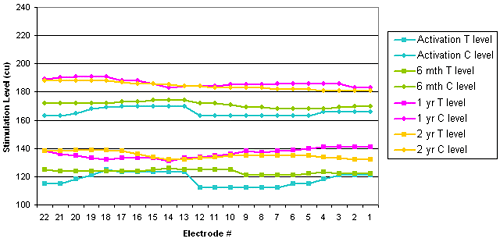
Overstimulation:
Overstimulation ("overstim") is the term used to describe cochlear implant map settings with stimulation levels exceeding the amount needed to create the desired percept. Overstim can occur due to a lack of patient participation, pressure from the parents/therapists, and/or inappropriate or inaccurate implementation of objective measures. When stimulation levels are set too high, sound quality and auditory skills can be affected.
Adult patients have previously described how changes in their map impacts their listening experience. If threshold levels are set too high, soft sounds are perceived as loud. For example, a light tapping sound could be perceived as a loud knocking sound, and in effect, consonant sounds could be heavily distorted. Although children may overcome the difficulty in perceiving and distinguishing between consonant sounds when they are distorted in this manner, the child may exhibit poor speech production skills since they are producing the sounds as they are hearing them. Overstim might also exasperate background noise, resulting in poorer listening abilities in noise.
Adult patients have sometimes caused their own overstim by falsely assuming that setting their comfort levels louder results in clearer sound, when in fact, the opposite occurs. When C/M levels are too high, patients describe experiencing echoing, bubbly, or wavering sounds. However, these subjective descriptions can also exist when a person's comfort levels are set too low. Therefore, the patient may have to listen to a variety of sounds and comfort levels to determine the best map for them.
It is clear that focused and accurate participation during cochlear implant programming is the preferred route to creating an optimal map. However, children cannot usually provide such information due to their current language abilities and the complex nature of discussing concepts of loudness and sound quality. Difficulty expressing their CI experience paired with unreliable behavioral information (due to lack of participation, attention problems or poor behavior) can lead to map settings that are inappropriate. Therefore, case studies are offered here (below) to demonstrate the effects of overstimulation.
Case Studies:
Case Study One
Patient Initials: AB
Age at Implant: 2.0 years
Age at last visit: 2.9 years
See Figure One
A mother of a young cochlear implant user was concerned over her daughter's voice quality and investigated a second opinion outside of her programming center. AB was reportedly "doing well" with her cochlear implant and developing auditory skills, however, her speech had a "deaf speech" quality. A pre-programming audiogram was completed while wearing her CI. Thresholds obtained using conditioned play techniques were seen around 35-40dB at test frequencies 250Hz-6000Hz. AB participated in the remapping of her cochlear implant using a conditioned play activity (CPA). However, the clinician observed that her behavior was indicating that she was hearing at levels softer than those she was responding to during CPA. Therefore, the clinician could not measure her "true T" level and had to use her behavioral responses to create her CI program. This resulted in stimulation levels that were much lower then what she was previously using. The clinician mirrored the C levels to match T levels with an appropriate dynamic range. A post-programming audiogram was obtained which revealed threshold improvements to around 20-25dB in the test frequency range. AB immediately began responding to sound more consistently at home and at school and her voice quality improved. During a follow-up appointment AB was responding much closer to her "true T" level during the CPA task and the clinician began to train the child to participate in a loudness growth task. AB showed no adverse responses to sound, which is an important observation since it can contribute to comfort levels being set too high.
It is suspected that AB was producing speech with a deaf speech quality with her old CI settings due to her high frequency stimulation levels being set too low. Electrodes 1 through 7 are responsible for frequencies of 2000 Hz and higher, and as they were programmed, she was unable to detect sounds. Interestingly, her audiogram showed hearing thresholds at 35-40dB across all frequencies. It is unknown why this would occur. Perhaps it was the stimulation of the C levels helping her to respond? This child was a well behaved and eager participant in the conditioned play games. However, she was challenging to program due to her consistent responses well above her T level and the need of an experienced observer. After changing her map, AB achieved one year's gain in a six month period on the Reynell Language Development Scale. It is not known if this growth in language was due to; improved perception of speech, educational placement, the support system, other causes intrinsic to the child herself, or a combination of these factors.
Figure One: The stimulus levels are plotted for each individual electrode for a 2 year old girl six months post implant with deaf speech characteristics. The old C levels are not providing enough stimulation in the high frequency electrodes (#1-7) and the low to mid-frequency electrodes are set higher than needed.
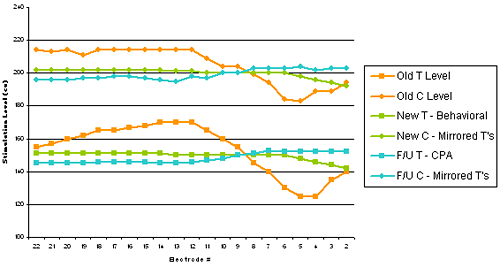
Case Study Two
Patient Initials: CD
Age at Implant: 3 years
Age at last visit: 6 years
See Figure Two
A family sought a second opinion regarding their son who had received a cochlear implant. His parent's were concerned over the child's lack of auditory attention and progress with his cochlear implant after 2.5 years of use. CD had some receptive understanding, but little expressive abilities with poor eye contact. CD reportedly wore his cochlear implant all waking hours and had never shown an adverse response to sound or to his device. CD's cochlear implant was remapped by first obtaining NRT levels and then using that information to train him to participate in a conditioned play activity to set T levels. The clinician noticed CD would stop responding if she presented stimuli around the NRT level, and suspected this could be the reason why his previous maps were set too high. In other words, his previous clinician may have tried training him to the CPA task using a stimulus beep that was too high, and in response he would not participate. If a child does not participate, the clinician has no choice but to create a map using their clinical experience and knowledge, which may or may not be accurate. With the new map settings, which have significantly lower stimulation levels, CD immediately began using his voice more and attending to sounds around him. His parents reported not seeing this behavior previously. CD responded to the Ling sounds at a moderate to soft voice level. At the follow-up programming appointment a few weeks later, CD was able to detect and repeat all Ling sounds at very soft levels. His parents reported this was a new skill for the child. After a few months of receiving auditory therapy at our center, the family moved to an area of the country where oral deaf services are prominent with hopes of further improving their son's performance.
Figure Two: The stimulus levels are plotted for each individual electrode for a 6 year old boy who had not developed auditory skills with his cochlear implant after 2.5 years of use. The clinician who saw him as a second opinion case noted that the child would not participate in the conditioned play activity when the stimulation levels were around his C level. Children are typically trained to the task around this level but since he did not respond his previous clinician may have assumed that he was not hearing or responding to the sound.
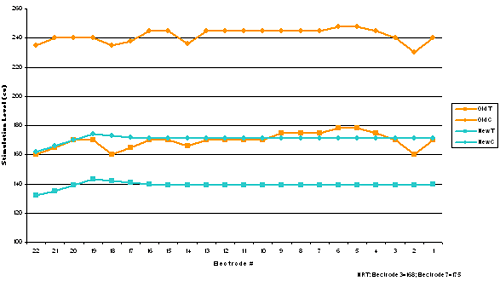
Case Study Three
Patient Initials: EF
Age at Implant: 18 months
Age at last visit: 4 years
See Figure Three
EF was not seen for regularly scheduled program checks during her 2.5 years of cochlear implant use. EF would not participate in audiograms or in the programming of her cochlear implant. As a result, stimulation levels were slowly increased over time as she visited different clinicians. Following her two year assessment and program check, her school reported an increase in negative behaviors in the classroom. EF was easily agitated and would frequently throw tantrums. The classroom teachers did not believe these behaviors were hearing related. EF always performed well in the classroom, was steadily developing her speech and language skills and always successfully completed her daily Ling six sound check. EF was seen for a remapping shortly after her two year evaluation. During remapping, it was evident she was consistently hearing stimulus beeps from the computer and not responding. A new map was created with lower stimulation levels using her behavioral responses. At first, EF was upset because the sound of her CI was so different. When she returned to class, she reported everything was too loud and there was too much noise. Her teachers were counseled to prepare for this response and worked with the child to comfort her and reorient her to the classroom environment. The child was not responding to basic environmental sounds, to which she had previously responded to. After two weeks of using the new program the child began using fuller sentences. For example, "Whadat?" became "What is that?". Performance in therapy sessions and in the classroom significantly improved and incidental listening was observed. EF attended to 'the teacher's conversations and participated in jokes and silly games. These behaviors were documented in her therapy progress reports and in her classroom IEP log. EF decreased the number of tantrums she had in the classroom and has become a better negotiator. She was again seen for follow-up a few weeks after her stimulation levels were decreased. The child was more reliable during programming and her levels were decreased even more, while maintaining her 84% PBK word score.
Figure Three: The stimulus levels are plotted for each individual electrode for a 4 year old girl. Due to lack of participation and a lack of objective measures obtained, stimulation levels were slowly increased over time unnecessarily.
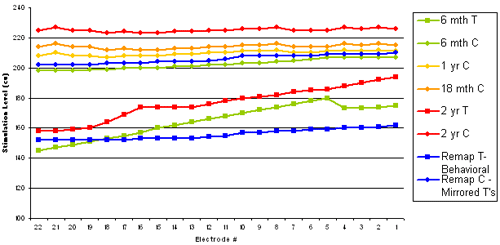
Case Study Four
Patient Initials: GH
Age at Implant: 2.5 years
Age at last visit: 6 years
See Figure Four
GH was followed extremely closely for program checks. His parents would frequently report that they "could tell it was time for a mapping" and say that the child's speech was sloppy and list the errors he would make in speech production. GH's audiogram was always around 20-35dB and did not consistently change when map changes were made. GH never showed any adverse responses to sound or to his CI and he was an excellent CI user. Over time and over many programming appointments his stimulation levels slowly increased and were approaching the maximum output of the default parameter settings (Figure 4 (a)). NRT measurements were made at his three month post activation appointment showing that an audible signal is present at 160 clinical units, which correlated with his map settings at that time. However, by his two year post activation appointment his C levels had reached an average of 220 clinical units. GH currently exhibits many obsessive-compulsive behaviors and is very particular about who touches his cochlear implant. He only allows those that he truly trusts to touch or change his equipment. If any changes are made to the settings on the processor he would become extremely upset and cry until it was changed back.
Figure 4 (b) shows how GH's cochlear implant program was changed after he was retrained of how to respond during a programming session. His language abilities were above his age level, so the reasoning behind the programming process was explained to him. He was encouraged that even if the stimulus beeps were "very little" he could go ahead and participate in the CPA activity. He was persuaded to focus on the task by explaining that the clinician was going to try and trick him and he did not want to miss the beeps. Even through this training, the child would not respond to his "true T" level. From his behavior, you could tell that he would wait until he was definitely sure he heard the beeps. Again, as seen in many of the case studies provided here, this child did not show any adverse response to stimulus beeps presented at a high stimulation level. He also shows extreme difficulty in judging loudness in live voice mode because he can only focus on the fact that the sound is different and that he does not want it to be different. By redirecting him and comforting him, he allowed himself to use the new settings and eventually adjusted to them after only a few days of complaining that he did not like the sound. Although he could not identify the Ling sounds after the program changes (he could only detect the sounds), after a few days of use, his identification abilities improved and he was back to his baseline functioning. After lowering stimulation levels he was able to maintain his 92% PBK word score.
Figure 4 -A: The stimulus levels are plotted for each individual electrode for a 6 year old boy. This child was an excellent CI with high expectations to meet. His stimulation levels were slowly increased over time inadvertently by his cochlear implant clinician.
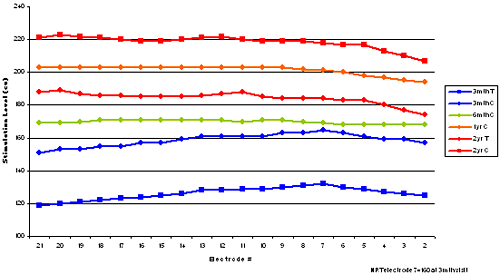
Figure 4 -B: Map changes after training during cochlear implant programming session. The child initially did not prefer the sound of his new program and could only detect the presence of Ling sounds at a soft level. After a week of wearing the new settings, GH was fully adjusted and happy with his program. His ability to identify and repeat the Ling sounds returned and he maintained his 92% PBK word score.
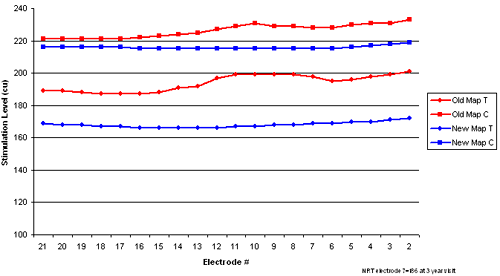
Summary:
There are many reasons why children would be susceptible to having stimulation levels that are set too high for their individual needs; lack of participation by the child, absence of adverse responses to sound, no continuity of care (unfamiliar clinician may not see subtleties in child's behavior), expectations of the child are too high (by their therapist or parent), remapping the CI too often, misconception that "louder" is better, clinician inexperience or a combination of these factors. The signs that overstimulation in a CI map may be present are:
- Audiogram does not seem to change with map changes and may never achieve desired level or the audiogram decreases over time.
- Speech intelligibility is poor
- Plateau in language abilities at a young age
- Lack of bonding with CI
- Map stimulation levels increasing over time
- Child is easily agitated
- Extremely poor performance in the presence of background noise
When determining if your patients are affected by stimulation levels inadvertently being set too high, consider the CI population in your clinic and what the average map looks like. Are your pediatric maps different from your adult maps? Notice the configuration of the stimulation levels and the average range in which they fall.
An observant eye for behavioral responses is important when programming patients, both children and adults. Children (and even some adults) do not respond to a true T level during psychophysical measures, even though they may be very consistent during an audiogram. When creating a cochlear implant map, use your "clinical gut"to create T and C/M levels where you believe they should be based on the child's behavior and/or objective testing. Mirror T and C/M levels with an appropriate dynamic range. Counsel the family and warn therapists and teachers who work with the child that they may notice CI performance as being "off" for a week or two. Only after the new map is tried for a period of time on a consistent basis can an accurate judgment of the child's performance be made. As long as the child can detect the presence of the Ling six sounds, the clinician can have faith that they are hearing appropriately. Changes may or may not be reflected in the audiogram right away (see note below). A follow-up appointment should be scheduled a few weeks following the map changes to be sure that the child is progressing as expected. After using the new settings for a period of time the child will be able to give better feedback of what they are hearing (ex. Identification of Ling sounds will return, speech perception will return to baseline). Multiple appointments may be required to get stimulation levels where they should be.
After the child has adjusted to the new settings their participation during programming may improve and the clinician will be able to obtain more information to further optimize the map. Although working with patients to decrease their stimulation levels seems to be a daunting and time consuming task, there are many benefits in undergoing this endeavor. Negative side effects of high stimulation levels exist, including risk of facial nerve stimulation, increased channel interaction, low battery life, voltage compliance issues and may result in an eventual degradation of the speech signal. Most importantly, there are unknown physiological side effects by maintaining high stimulation levels. The topic of overstimulation raises many questions that professionals in the cochlear implant field may want to consider:
- How is it that some children continue to develop their skills while using inappropriate stimulus levels while others do not?
- Would these individual differences be present regardless of the map settings?
- What affect does individualized plasticity of the brain have on how electrical information is managed as hearing?
- Is it possible that we as cochlear implant clinicians are causing poor outcomes in our pediatric patients by inadvertently increasing the stimulation levels over time?
- How can we better counsel and educate parents and therapists on appropriate stimulus levels and dispel the myth that "louder is better"?
References:
[1] Brown CJ, Hughes ML, Luk B, Abbas PJ, Wolaver AA, Gervais J (2000). "The relationship between EAP & EABR thresholds and levels used to program the Nucleus 24 speech processor: data from adults" Ear and Hearing, 21, 151-163.
[2] Hughes ML, Brown CJ, Abbas PJ, Wolaver AA, Gervais JP (2000). "Comparison of EAP thresholds with MAP levels in the Nucleus 24 cochlear implant: data from children" Ear and Hearing, 21, 164-174.
[3] Cullington H (2000). Preliminary neural response telemetry results. British Journal of Audiology Jun;34(3), 131-40.
[4] Sun YS, Wu CM, Liu TC (2004). " Mandarin speech perception in nucleus CI 24 implantees using MAPs based on neural response telemetry" Journal of Otorhinolaryngology Related Specialties; 66(5), 255-61.
[5] Seyle K, Brown CJ (2002). "Speech perception using maps based on neural response telemetry measures" Ear and Hearing, 23(1 Suppl), 72S-79S.
[6] Stephan K, Welzl-Muller K (2000). "Post-operative stapedius reflex tests with simultaneous loudness scaling in patients supplied with cochlear implants" Audiology, 39(1), 13-8.
[7] Hodges AV, Butts S, Dolan-Ash S, Balkany TJ (1999). "Using electrically evoked auditory reflex thresholds to fit the Clarion cochlear implant" Annals of Otology, Rhinology & Laryngology Suppl. 177, 64-8.
[8] Bresnihan M, Norman G. Scott F, Viani, L (2001). "Measurement of comfort levels by means of electrical stapedial reflex in children" Archives of Otolaryngology-Head & Neck Surgery, 127(8), 963-6.
[9] Zwolan TA, Overstreet EH (2005). Presentation on average stimulation levels at AARO meeting.
[10] Overstreet E.H., Belagaje, S.R., Kirk, K.I., Lormore, K., Wang, K., Zwolan, T.A. (2005). Poster presented at 10th Symposium on Cochlear Implants in Children, March 2005.

